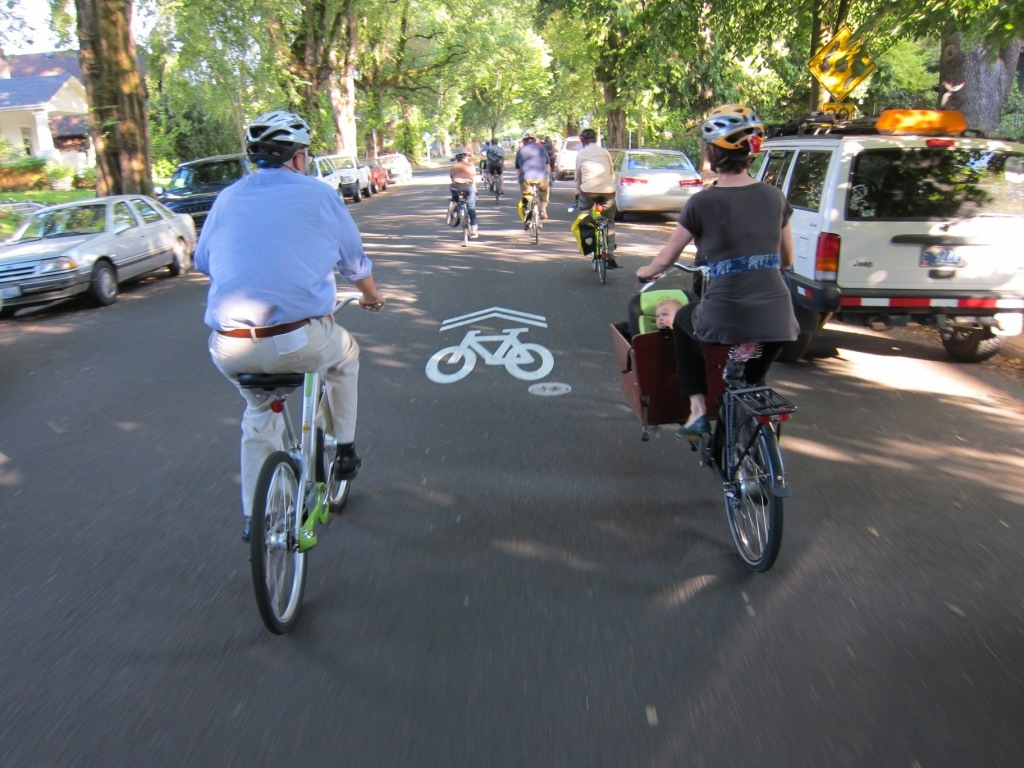What are Neighbourhood Greenways?
See also our Neighbourhood Greenways workshop presentations page and click here to see an example of our work.
There are a variety of names around for this cycle network tool. Originally, they were called Bicycle Boulevards. Neighbourhood Greenways then became a name that has maybe become most common now. We haven't got any of them in New Zealand yet, but Dunedin is about to establish some, and there they are called Quiet Streets. So what exactly is it?
Definition
A basic definition is: "A roadway with low motor traffic volumes and speeds designed to provide a safe, attractive, convenient and comfortable cycling environment." So basically it's a piece of quiet road where cyclists share the space with cars. But will that work, you may ask? Yes, it's been used very successfully in many cities around the world. Where can I have a look at an example? Well, nobody has ever done it before in New Zealand. You expect this to work with New Zealand drivers? Well, unlike many good cycling inventions, this concept does not come from Europe, but from the car-loving United States. And if it works there, there's no reason why it wouldn't work here.
Design concept
So what makes a good cycling environment? First up, it only works if there isn't too much traffic, and the traffic that does use the road shouldn't be going too fast. The Americans have, through trying it out, found that fewer than 1,500 cars per day are preferred, and ideally, you want to create an environment where drivers don't exceed 30 km/h (NACTO (2014). Urban Bikeway Design Guide. Washington, Island Press, p. 154).
How about speed - is this about posting a 30 km/h speed limit? No, it's not. It's about changing the road environment so that most drivers wouldn't want to go any faster. It's possible to design road environments so that this will happen.
So what else will happen? Well, when you currently cycle on local roads, on average you'll come to a give way or stop sign at every second intersection with another local road. Those corridors that we pick as Neighbourhood Greenways will have their intersections with other local roads changed so that it's always the side street that gives way. That's great for cycling, as you can keep your momentum. And when you come to an intersection with a busy road, what is needed is a crossing help. This can be as simple as an island in the middle of the busier road, but sometimes traffic signals are needed to help cyclists across.
You might ask that if it becomes so much easier to cycle along a Neighbourhood Greenway, doesn't it then also become more attractive to drive along it? So won't those measures attract more traffic, which is the opposite from what we want? Correct, and that is why we'll include measures like short sections of one-way street for motorists, so that the route doesn't become a "rat run", but we'll keep those sections open for cycling in both directions.
This will of course be done in a way so that every resident can get to and from their property; access will always be maintained. It does mean, though, that some restrictions will be put in place, so people may have to change their normal route of driving.
So what will Neighbourhood Greenways mean for residents? In short, traffic volumes may reduce (or they may stay the same as they were before), but speeds in front of people's houses will drop. It's like getting the advantages of living in a cul-de-sac, and living on a Neighbourhood Greenway will become an attractive proposition. Experience from other cities shows us that after a while, there will be much more demand for Neighbourhood Greenways by residents groups than what a council can provide, as the corridors will have to be chosen in a strategic way so that it creates a useful cycle network.
{2019 update: We are now starting to see a number of neighbourhood greenways being built in NZ, especially in Christchurch. Further international experience is also gathering on these and other "bicycle streets" - contact Glen Koorey for more details}
Credit and further information
The photo taken by Mia Birk is used with her kind permission; Mia is a principal at Alta Planning. Further information on this topic can be found in the Bicycle Boulevard section of the Urban Bicycle Design Guide published by NACTO. If you work for a local authority and are interested in discussing this concept further, please contact us!


